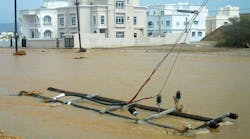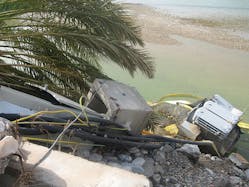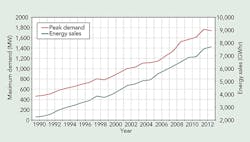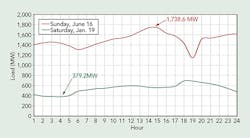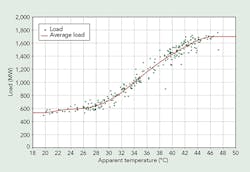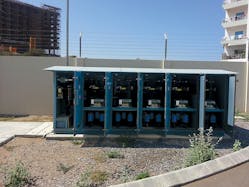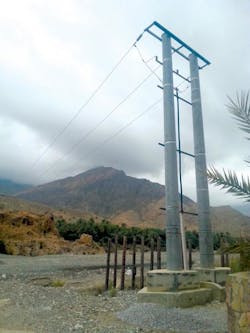The Muscat Electricity Distribution Co. (MEDC) distribution network is supplied by the Oman Electricity Transmission Co. (OETC) from 19 132/33-kV substations. Another six substations are scheduled to be commissioned over the next five years. The peak electrical demand in the governorate has grown from 464 MW in 1990 to 1763 MW in 2012, reflecting the governorate’s part in the large economic development of the country and the accompanying growth in population. There is an annual growth in the peak demand of 6.3% and an average growth of 5.7% in energy sales. This annual growth represents a doubling of the distribution network every decade or so, presenting MEDC with a demanding challenge to plan its new networks in a timely fashion.
MEDC operates in an arid climate with long, very hot summers and warm winters. Summer normally begins in mid-April and continues to October with temperatures ranging from 31°C to 38°C (89°F to 101°F), but they can go as high as 49°C (120°F). Temperatures in the winter months are pleasant and normally range from 18°C to 26°C (64°F to 79°F).
The annual rainfall is around 100 mm (4 inches) per year, with December to April being the rainiest months. The rainfall tends to be heavy and, when it occurs, can result in significant flash flooding in the dry river valleys, often causing the loss of lives. Muscat has experienced two major cyclones in the last seven years with Category 5 Cyclone Gonu in 2007 and Category 4 Cyclone Phet in 2010, both of which caused widespread damage to the city of Muscat’s infrastructure including the distribution networks.
Electrical System Development
The majority of MEDC’s 145 primary substations are equipped with two 33/11-kV, 20-MVA transformers or three 33/11-kV, 20-MVA transformers. However, because of the network’s short circuit levels, the three transformer substations cannot be run in parallel. A recently completed techno-economic study recommended an auto-switchover scheme, whereby, in the event of a loss of one transformer, the resulting momentary supply interruption would satisfy the security of supply standard.
The majority of distribution transformers installed are 1-MVA ground-mounted units. With the exception of mountainous and remote rural areas, underground cables are installed on all 33-kV and 11-kV circuits. A significant proportion of the overhead line circuits installed in the urban areas of the city of Muscat have been undergrounded over the last five years as part of a project to improve the visual amenities.
Load Characteristics
MEDC’s daily load profiles for days with maximum and minimum demands in 2013 illustrate the reason why the annual system load factor is 50%. This is significantly lower than the annual system load factor for typical European or North American utilities, where the average load factor is closer to 65%. This difference is largely a result of Muscat’s extreme heat intensity in the summer months, with its accompanying air-conditioning loads, and pleasant winter temperatures, when there is an absence of heating and cooling loads.
MEDC has been studying the relationship between system loads and weather conditions to gain a better understanding of load behavior for forecasting purposes as well as weather normalization of loads for analysis purposes. The increase in load is highly dependent on the combination of dry-bulb temperature and the relative humidity. An analysis conducted by MEDC confirmed the Steadman apparent temperature (AT) heat index, which combines both temperature and humidity, correlates most closely the utility’s total system loads.
Applying a simplified form of this index, the wind term is removed because the wind chill effect is not applicable in Oman’s climate conditions. By studying the 3 p.m. system loads on workdays during 2012, the system load characteristics show lower boundary saturation occurs when all air-conditioning loads are switched off and upper boundary saturation occurs when air condition is in operation. Based on the results of this analysis, MEDC concluded nearly 70% of the electrical demand during the peak-load summer months is a result of the air-conditioning load.
Therefore, a large percentage of the load is deterministic in nature, and this is reflected in the average load characteristic. The actual daily loads that occurred fluctuated and showed a normal distribution with a mean of nearly zero (from the expected load value for that AT) as well as a standard deviation of approximately 70 MW in 2012. The peak demand in 2012 was 1763 MW, and despite the underlying load growth (that is, a similar number of new customer connections), the peak demand in 2013 was a little lower at 1739 MW. When examined from the perspective of number of hours spent above a specific AT, the reason for this difference was identified. In 2012, the summer was hotter with 660 hours over an AT of 42°C (108°F) compared with just 380 hours over 42°C in 2013, with the hottest part of the day normally occurring between 12 p.m. and 3 p.m. when the system peak load occurs.
Using probability theory, as the actual loads normally are distributed around the expected values, the probability of certain peak loads can be estimated with a given summer heat intensity. Since 2012 was the hottest summer in the last five years, it produced a higher peak load than would otherwise have been expected. Since 2013 was the coolest summer in that period, it produced a lower peak load than the previous year, notwithstanding the underlying growth trend.
Despite the variability of actual loads around the forecast value, the system peak load in four of the last five years has occurred in the first half of June, on a workday from 2 p.m. to 3 p.m. Despite the fact hotter weather may occur later in the summer, general activity factors create a reduction in the load as schools have closed for the summer, workers start taking their summer holidays, which, in the context of Muscat, normally means citizens leave the city and return to their homes in other regions of Oman.
The findings from this research already are being used in a newly created day-ahead hourly load forecasting report to the OETC and also will be used for longer-term load forecasting in the three yearly system-capability statements and longer-term master planning. Also, these results will be applied to the environmental criteria for the regulatory security of supply compliance assessment.
Annually, it is a high-priority activity for MEDC to prepare for the summer peak loads to ensure the necessary load rebalancing between primary substations is completed. As air conditioning in hot weather is extremely important, in the event of a network outage, whether short or long term, customer tolerance levels are extremely limited.
Asset Management Certification
MEDC is in the middle of a program to achieve PAS55 certification in asset management as one of its five strategic initiatives underway. It is targeted to achieve certification by 2016; two significant gap analyses have been completed already to assess deficiencies and progress, with a further audit scheduled to take place in 2014.
As a major part of this program, IBM’s Maximo computerized maintenance management system is being introduced at MEDC. The first phase of the system was commissioned in early 2014 and included all primary substations and 33-kV circuits. Training and development in asset management has taken place, and the technical skills and experience in the new asset management department are being augmented with external recruitment. The most significant benefit of using Maximo is that actual maintenance progress compared with the annual plan can be monitored in real time, and dynamic asset data can be recorded centrally and used in strategic analysis. This management information facility was not possible with the previous decentralized paper-based system.
SCADA
MEDC currently operates its network using field-based operational engineers and a control room with access to the supervisory control and data acquisition (SCADA) system in grid stations to coordinate switching and outage activities, as, at present, primary substations do not have SCADA capability. A major project is now underway to install SCADA facilities in all primary substations, and a new control center currently under construction also will have facilities to manage major outage emergencies.
The SCADA system will comprise a PSI master system, ABB 560 remote terminal units and a communications network based on a combination of fiber-optic and multiprotocol label switching (MPLS), with some use of general packet radio service (GPRS) for backup channels. This system is being commissioned in 40 primary substations in 2014, with the remainder being equipped by mid-2015.
An important part of this project is control center staff training. MEDC has partnered with TNB Distribution Malaysia to train the staff in the same PSI SCADA system. MEDC also is developing its own in-house SCADA team, which is currently working with the project contractor on how to maintain and expand the system following the project completion. The SCADA system also will be an important source of accurate load data on the distribution network.
Power Quality
In 2013, MEDC completed a project to assess the power quality (PQ) on its network. Undertaken in the summer months, this project included one-week deployments of PQ analyzers at low-voltage points in various distribution substations. The results were then compared with national and international PQ standards for public networks. Apart from a flicker issue at one substation — caused by an industrial customer — which is now rectified, all of the results complied with the international standard EN50160. Further PQ assessments will take place focusing on the winter performance of the network. MEDC plans to complete a cost-benefit analysis to compare the cost of permanently installed PQ analyzers with temporarily installed PQ analyzers.
Despite the high level of air-conditioning units supplied by the distribution network, the power factor is always maintained above 0.90 and is generally above 0.95. Every primary substation is equipped with two 5-MVAR capacitor banks switchable in 1-MVAR steps, normally by automatic control. A program of power factor correction was launched a few years ago, and this has corrected a previous problem effectively, whereby the power factor on the 11-kV bus bars often fell below 0.80.
Distributed Renewable Generation
A recent consultant’s report was commissioned by the regulator to assess the potential for renewable energy generation in Oman. The report confirmed Oman has considerable potential to develop solar and wind renewable energy plants. Currently, MEDC has no renewable generation connected to its distribution network. One solar photovoltaic project with an installed capacity of 600 kW is scheduled to be commissioned in 2014 or 2015.
In conjunction with the Public Authority for Electricity & Water, MEDC is embarking on assessing the performance of a 9-kW hybrid wind photovoltaic renewable generator. MEDC will be responsible for the installation, operation and maintenance, and performance assessment of this facility for approximately two years. This will be an important training and development tool to familiarize MEDC engineers with renewable technologies, as strategic targets for the electricity sector mean distributed renewable generation will become increasingly common on the distribution network in future years.
Overcoming the Challenges
The planning, design, construction, operation and maintenance of an electrical distribution network in Muscat presents several unique and difficult challenges:
- Unlike typical utilities in Europe and North America, the peak load on the network occurs during the hottest summer months, and requires equipment and conductors to be rated significantly above what would otherwise be required. The critical nature of electrical supply during the long, hot summer months means reliable and continuous supply to customers is absolutely critical, as any supply interruptions quickly escalate into political and public relations issues.
- The steep mountainous and hilly terrain rule out the use of underground cables. The construction of overhead lines often requires considerable manual handling of the materials to site during construction as well as necessitating special steep-slope design considerations.
- The valleys present a unique challenge as flash flooding can result in grounding the overhead lines crossing them. MEDC has experimented with different designs for the 33-kV and 11-kV lines to overcome this problem, including using special long-span crossings with lattice towers. Also, all structures previously positioned in valleys have been removed and replaced by cables in concrete ducts. Both solutions have produced significant improvements in the network reliability during heavy rain periods.
- An additional difficulty presented by the valleys is the inability to cross them when flooded. To restore supplies as quickly as possible after the rains, repair crews often have to be placed strategically at different locations around the valleys before the rain falls to be able to access all sections of the distribution network. This necessitates considerable planning and experience by the operational staff to place field crews in the most advantageous locations.
- The dusty environment of the region is ever present and the combination of dust and rain cause significant escalation in the frequency of contamination-related transient faults on overhead lines. MEDC has started using silicon-rubber insulators because of their superior performance and, subject to their results, may opt to retrofit overhead line insulators on existing lines.
MEDC has overcome these and many other engineering challenges successfully as it continues to improve system performance annually while almost doubling the size of its distribution network every decade. The strong commitment of management and staff to provide a safe and reliable electrical supply to the residents of Muscat has always been a strong feature of the utility, which has been crucial in securing continual success.
Joseph MacEnri ([email protected]) graduated with a degree in electrical engineering from Trinity College Dublin in 1989. He has worked since then in the field of transmission and distribution electrical engineering. He was a senior consultant with ESB International in Dublin, working with the electrical utility in Ireland and clients internationally from 1989 to 2012. In 2012, he moved to Oman and joined Muscat Electricity Distribution Co. as senior manager of planning and asset management.
Hussain Al Lawati ([email protected]) graduated with a degree in electrical engineering from Oman Technical College in 1992 and a MBA degree from the University of Bedfordshire in 2010. He has worked in Muscat Electricity Distribution Co. and its predecessor, the Ministry of Electricity & Water, since 1992 in a variety of positions from field operations engineer to manager of technical services. In 2012, he became manager of the newly created asset management department.
Abdul Aziz Al Sinani ([email protected]) graduated with a degree in electrical engineering from Sultan Qaboos University, Muscat in 2001. Since 2001, he has worked in the electricity sector in Oman and at Muscat Electricity Distribution Co. since it was established in 2006. Al Sinani managed the distribution control center for several years before being appointed manager of the planning department in 2010.
Rasheed Al Balushi ([email protected]) received a degree in electrical engineering from Vocational Training Institute in 1991 and a bachelor’s degree in information system development from the University of Bedfordshire (Luton) in 2004. He has worked as a technical specialist (protection, commissioning and communication) in the electricity sector as well as for 10 years as a team leader in the area of system protection and control in Oman. In 2013, he was appointed acting manager of the distribution control center at Muscat Electricity Distribution Co.
Mentioned in this article:
ABB | www.abb.com
IBM | www.ibm.com
Muscat Electricity Distribution Co. | www.medcoman.com
PSI | www.psioilandgas.com
Public Authority for Electricity & Water | www.paew.gov.om
TNB Distribution Malaysia | www.tnb.com.my
Muscat and the MEDC
The Sultanate of Oman — located in the southeastern corner of the Arabian Peninsula bordered by the United Arab Emirates to the northwest, Saudi Arabia to the west and the Republic of Yemen to the southwest — has an area of nearly 310,000 sq km (119,691 sq miles). The population of Oman has grown from less than 0.75 million in 1970 to an estimated 3.9 million, of which approximately 30% are expatriates. The main elements of the current Omani economy are oil, gas production and tourism.
The Sultanate is divided administratively into 11 governorates, with the governorate of Muscat, which includes the capital city and its surrounding rural areas, spanning an area of nearly 4000 sq km (1544 sq miles). Oman’s capital city of Muscat, situated on the country’s northern coastline facing the Gulf of Oman, has a population of almost 1 million. The Muscat Electricity Distribution Co. is responsible for the 33-kV and 11-kV distribution networks, which supply some 240,000 customers — 76% domestic, 21% commercial and industrial, and 3% government and municipality.
The governorate of Muscat comprises coastal plains generally a few kilometers wide while a significant area is covered by steep mountains and hills, many of which are quite inaccessible. Muscat has developed along the coastline northwestward from its historical port constrained by the Gulf of Oman to the north and steep mountains to the south. More recently, Muscat has developed a new district, Al Amerat, on the southern side of the mountains on an inland plain, and it is now one of the fastest-growing districts in the city.
Oman is a founding member of the Gulf Cooperation Council. The 400-kV transmission system operated by the Oman Electricity Transmission Co. is connected to the 900-km (559-mile) 400-kV ac transmission interconnector that links the six Gulf countries of Bahrain, Kuwait, Oman, Saudi Arabia, Qatar and the United Arab Emirates.
